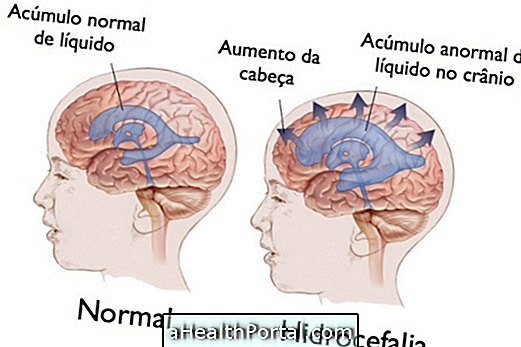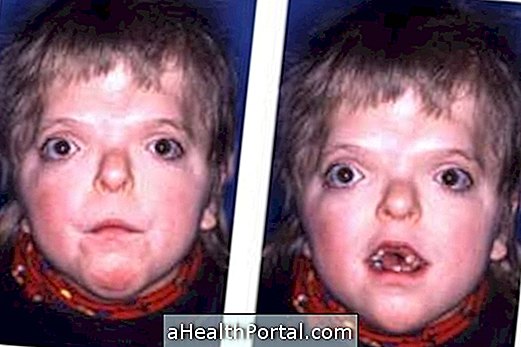A child's first year of life is fraught with phases and challenges. During this period, the baby tends to go through 4 developmental crises: at 3, 6, 8 and when he is 12 months old.
These crises are part of the child's normal development and are related to some "mental leaps", that is, moments when the baby's mind develops quickly, being marked by some behavioral changes. Usually, in these crises, babies become more difficult, cry more, get irritated easier and become more needy.

Understand the baby's crises during the first year of life and what can be done in each one. It is important to remember that each family has its structure, characteristics and possibilities and, therefore, must adapt according to them.
Crisis of 3 months
This crisis happens because until that moment, for the baby, he and the mother are a single person, as if it were a pregnancy outside the womb. This phase can also be described as a second birth, the first being biological, on the day of delivery and with the arrival of 3 months, psychological birth occurs. At this stage, the baby begins to interact more, to look into the eyes, to imitate gestures, to play and to complain.
The 3-month crisis happens precisely because the child has the perception that he is no longer trapped in his mother, understands that he is not part of her, sees her as another being and needs to call her to have what he needs, which can generate anxiety in the child. baby, being able to be perceived by more moments of crying. This crisis lasts, on average, 15 days and has some striking signs such as:
- Change in feedings: it is common for the mother to feel that the baby no longer wants to breastfeed and that her breast is not as full as it used to be. But what happens is that the baby is already able to suck the breast better and empty it more quickly, reducing the feeding time to 3 to 5 minutes. In addition, the breast no longer leaves so much milk in stock, producing at the moment and according to demand. At this stage, many mothers start supplementation because they think they are not offering enough milk for the child, which leads to a lack of stimulation and thus early weaning.
- Changes in behavior and sleep: the baby in this phase tends to wake up more often during the night, a fact that many mothers associate with the change in feedings and understand that it is hunger. Therefore, when the child cries, the mother offers him the breast, when he tries to let go the child cries and the two of them go back and forth, this is because the baby suckles even without hunger, as he feels safe with the mother, as when he understood that the two were one.
As this is the moment when the baby begins to discover the world, he becomes more active and his vision improves, everything is new and cause for agitation and he already understands that when crying his needs will be met, generating anxiety and sometimes irritability.
What to do
Considering that it is a phase of completely normal developmental adjustments and very important for growth, parents should try to stay calm and maintain a peaceful environment to help the baby through this, as in a few days the routine will return to normal. The child should not be medicated at this stage.
It is advised that the mother insists on breastfeeding because her body is capable of producing the necessary amount of milk that the child needs. Therefore, if the baby's grip is correct and the breasts do not hurt or crack, there is no indication that the baby is breastfeeding poorly and, therefore, breastfeeding should not be stopped. One point to note is that at this stage the child is more easily distracted, so seeking to breastfeed in quiet places can help.
Other methods that can help during this crisis include giving the baby a lot of lap and applying the kangaroo method, telling stories showing colorful drawings in books, among other actions that show contact and attention. See here what the Kangaroo method is and how to do it.
6-month crisis
Between the 5 and 6 months of the child, the family triangle is formed and it is at that moment that the child realizes that there is a father figure. As much as the father has been active since birth, the baby's relationship does not have the same meaning as it has with the mother, and only around six months does this recognition happen and then the crisis begins.
The signs of crisis are excessive crying, changes in sleep and mood, the child does not have much appetite and may be more needy and irritable. To confuse a little, the beginning of the birth of the teeth often happens during this period and the two phases can be confused, since the dentition also causes discomfort and the child can become more agitated and irritated, in addition to causing diarrhea and even fever. See the symptoms of the birth of the first teeth.
The 6-month crisis also happens to the mother and often affects her more than the child, who must deal with the father's entry into the relationship, and it is often during this period that many women return to work, intensifying their crisis.
What to do
This is the moment for the mother to give space and for the father to be present in the child's life, in addition to supporting and helping the mother. The mother must police herself so as not to feel guilt or jealousy, since she needs to increase the baby's network of contacts. Still, according to some experts, the baby's adaptation to the daycare is easier if done before 8 months, since in this period the parents still do not feel so much. Check out more about the development of the 6-month-old baby.

Crisis of 8 months
In some children this crisis can happen in the 6th month or for others in the 9th, but it usually happens in the 8th month and it is considered the crisis of separation, anguish or fear of strangers, where the baby's personality can change a lot.
This crisis is the one that lasts the longest, about 3 to 4 weeks and happens because the baby starts to be separated from the mother more often and, in his head, understands that she will not return, leading to the sensation of abandonment. There is a strong break in the sleep pattern in this crisis, the child wakes up all night and wakes up frightened and with intense crying. The other signs include agitation and loss of desire to eat, being more intense than in other crises. However, as this phase depends on the personality of each child, it is also common for some babies to go through the crisis smoothly.
What to do
Many couples take their child to sleep in the same bed with them, but this practice is not ideal because parents do not sleep peacefully for fear of hurting the child and there is this risk, in addition to alienating the couple and the child becoming very dependent from parents, demanding more and more attention. When the child has a crying attack at night, it is preferable that it is the mother to calm the child, because when the mother leaves, the child has the thought that he will not come back. This helps her to understand that the mother's presence can be followed by absences.
In addition, in this phase the child can become attached to an object defined by him / herself, which is important because it represents the figure of the mother and helps her to realize that, as the object does not disappear, the mother, even if she is absent, it will not disappear. Still, another tip is that the mother always embraces the object and then leaves it with the child, so that she can smell the mother and not feel helpless.
As in other phases, it is important to give affection and attention to the child to reassure him of his distress, in addition to always saying goodbye to the baby to make it clear that he will return and he will not be abandoned. A good example of play in this phase is hide and seek.
12-month crisis
This is the phase where the child begins to take the first steps and, therefore, wants to discover the world and be more independent. However, she remains dependent and in great need of her parents. The crisis happens precisely for this reason.
The main signs of this crisis are irritation and crying, especially when the child wants to reach an object or move somewhere and cannot. It is also common that the baby does not want to eat and cannot sleep properly.
What to do
As for the beginning of the walking process, parents should encourage the child to move, support, accompany and support, but never force, since the child will start walking when he thinks he can and when the brain and the legs collaborate. Even so, sometimes the child wants and cannot, which makes him anguished. It is advised that the environment is healthy, welcoming and peaceful, and even though this phase may be a little difficult, it is striking and very significant.
In addition, the more support and protection the child receives in this phase of separation, the better he or she tends to deal with it.
Was this information helpful?
Yes No
Your opinion is important! Write here how we can improve our text:
Any questions? Click here to be answered.
Email in which you want to receive a reply:
Check the confirmation email we sent you.
Your name:
Reason for visit:
--- Choose your reason --- DiseaseLive betterHelp another personGain knowledge
Are you a health professional?
NoMedicalPharmaceuticalsNurseNutritionistBiomedicalPhysiotherapistBeauticianOther
























